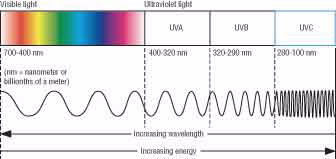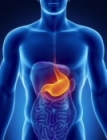Open for Discussion: A Tan - Quick, Easy, and Safe?
By Barbara Sitzman and Regis Goode
ChemMatters February 2012
Download article
Teacher’s Guide
WORD │ PDF
Regis: Wow! Prom season is almost here. My students are talking about their outfits, dinner, and dancing!
Barbara: Yes, they are also discussing getting great surfing tans to complete the “look.”
Regis: Let’s look at the process that produces the best tan. Your skin tans when exposed to ultraviolet (UV) radiation, an example of an interaction between energy and matter. Solar radiation is classified by wavelength: UVA, UVB, and UVC, from the least energetic to the most energetic, respectively (Fig. 1).
Figure 1

Figure 2

Barbara: All three types of UV radiation have sufficient energy to break chemical bonds. UVC is absorbed by the ozone layer in the upper atmosphere. Both UVA and UVB reach us and stimulate the formation of melanin, the substance that colors our skin. UVB burns the skin and damages DNA, triggering additional melanin production.
Regis: The interaction of UVB radiation with the skin has a good side. It produces vitamin D3, which helps transport the calcium needed for our bones. UV radiation has also been shown to improve mood and reduce stress.
Barbara: Tanning was not always perceived as healthy. Before the 1920s, if your skin was tan, you probably were a farm hand. When Coco Chanel, the French fashion designer, became tan while vacationing on a yacht, bronze skin became popular. Tanning in the sun, however, is not healthy. Exposure to excessive UV radiation makes the skin age and wrinkle prematurely. The more energetic UVB waves directly damage DNA, leading to sunburn, cataracts, and even skin cancers.
Regis: My students ask about the Sun Protection Factor (SPF) ratings on sunscreens.
Barbara: The SPF number is a “multiplier”: Minutes to burn without sunscreen x SPF number = maximum safe sun exposure time.
For example, it takes 12 minutes for your skin to burn, an SPF of 15 will protect you for 180 minutes (12 min. x 15 SPF = 180 min.). Doctors recommend a water-resistant sunscreen rated 15 SPF or higher with UVA and UVB protection, generally labeled “broad spectrum.”
Table 1
UVB is highest around midday due to increased reflection as the sun’s angle changes as a result of the Earth’s rotation.
| Time of Day | UVA | UVB |
|---|---|---|
| % of UV radiation reaching the earth | ||
| Before 10 a.m. / After 2 p.m. | 99% | 1% |
| Between 10 a.m. and 2 p.m. | 95% | 5% |
Regis: Some of my students use tanning beds for the perfect sun-kissed skin. Since the beds emit UVA, tanning is controlled with minimal risk of sunburn from UVB radiation. Aren’t tanning beds safer than exposure to the sun?
Barbara: Unfortunately, tanning beds are not absolutely safe. They primarily emit UVA, but some UVB is also present, both of which cause cataracts and make skin leathery. Frequent use of tanning beds triples the risk of getting melanoma, the deadliest form of skin cancer. The International Agency for Research on Cancer places tanning beds in its highest cancer risk category. UVB waves produce vitamin D3, but it is probably safer to obtain vitamin D3 from your diet or supplements.
Regis: Maybe the best tan is sunless. “Tan in a Can” products use materials that generate a tan without UV exposure. Creams, gels, lotions, and sprays contain dihydroxyacetone (DHA) [Fig. 2], a sugar that colors the outer skin cells. Unfortunately, this nice tan usually lasts only one week because you constantly shed dead cells.
Barbara: Tanning materials using DHA are effective, but the U.S. Food and Drug Administration has approved them for external use only, with warnings to avoid contact with the lips and eyes. Other precautions include testing for allergic reactions and using a sunscreen because DHA provides no UV protection. These products can be expensive and require several hours for the color to develop.
Regis: If you are going to have fun in the sun, do it safely. Scientists have not yet determined exactly how much UV radiation causes cancer. However, we can measure each type of UV during the day. According to Table 1, it is important to stay out of the sun between 10 a.m. and 2 p.m. and to remember that UVA penetrates both clouds and the glass of your car windows. So, wear sunscreen, even on a cloudy day.
Also in this issue (February 2012)

Attack of the Gluten
Some people have skin rashes and stomach cramps when they eat foods that contain gluten, a substance found in wheat, barley, and rye. Why are these people sensitive to gluten, and what can they eat instead?

24 Hours: Your Food on the Move!
What happens to food after we eat it? We usually don’t think about it, but our body does an amazing job at keeping the nutrients that we need and throwing away the food parts that we don’t.
Join the Discussion

ChemMatters Forum
As you think about tanning, which method will you choose? Will you simply decide to keep your skin as it is? This is a difficult decision. What will you do? Let us know on the ACS Network!

